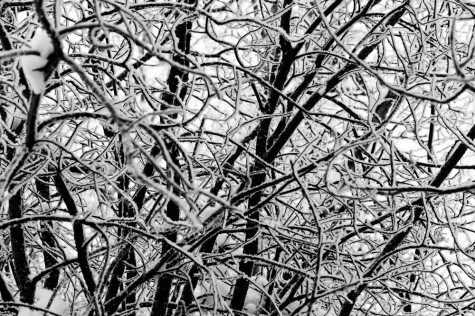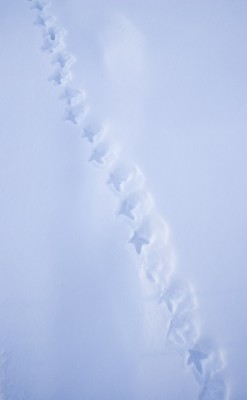After a couple centimeters of fresh, powdery snow, I went for a walk at the Strathcona Science Park along the North Saskatchewan River. In one area there were nearly a dozen spots where a magpie had dropped into the snow, leaving these beautiful impressions of its wing tips and long tail—thrown into beautiful detail by the low angle of the sun these days. I couldn’t tell what it was after under the snow, and I didn’t see any other magpie tracks outside of this one small area. If you have ever seen something similar, I’d love to hear you think this bird might have been up to.
|
||
|
Here’s another detail-oriented image taken during our recent spell of grey, overcast winter days. As I mentioned in a previous post, when the light is diffused so evenly by the low, bright stratus clouds that are common over central Alberta in the winter (especially the past few weeks), it’s often these close-up, detail oriented compositions that I find work best. I don’t commonly convert images to black and white, and even less often do I process them quite as heavily as I have here. While the contrast was fairly strong to begin with, I’ve “crushed” the darks all the way down, and bumped the background sky all the way up, to really emphasize the somewhat abstract pattern of the tangled branches, accentuated by the lining of snow and frost. Perhaps I’ll also post the original version as well, and I would love to hear your comments as to which you prefer. 
To continue the line of thought from my last entry, another type of composition that I find can work on grey, overcast winter days when the light is perfectly flat and even is a “high-key” image like this one. If there’s fresh snow, the whole landscape can turn the same colour–light grey. I find the trick is to ensure that my exposure is bumped up a little bit to turn the greys to white, and to find a little bit of contrast (spruce are great for this) for visual interest. These very subtle, almost monotone, images really capture the feeling of these most-subtle of winter days. 
In central Alberta the cold snap is over, and a prolonged case of the “winter-stratus” has set in—stratus clouds, that is. These are low, featureless clouds and in winter, when there isn’t much moisture, they are generally light grey to nearly white. Sometimes, like yesterday afternoon, they’ll lift a little to where you might call them altostratus, and you’re more likely to catch a little break for the sun to peak through. These are probably the most common clouds (stratus and altostratus) over Edmonton during the winter when there’s not enough solar energy to build a decent cumulus cloud. (I think I may be letting the cloud-watcher nerd in me show a little here). Photographically speaking, stratus clouds make the light perfectly flat and even, which can be both a curse and a blessing. Generally, the contrast of side light and shadows makes for more dramatic images than the flat light under a stratus ceiling, but I find that sometimes detail-oriented compositions benefit from the “huge softbox in the sky” effect. I enjoy the challenge of finding these photographs on days that would normally be considered photographic busts. 
I was sent a photo recently of an unidentified bird out at Elk Island National Park that turned out to be a Ruffed Grouse. The same day I had been out taking photographs at Ministik Lake Game Bird Sanctuary, which is just south of Elk Island, and had come across a fair number of grouse tracks in the dusting of fresh snow that had fallen overnight (this photo was taken at Ministik, but a couple years ago). The tracks are quite distinctive with the wide snowshoe-like toes, and it’s interesting to see where the birds come and go. Keep an eye out for these next time you’re in the fresh snow. 
Here’s another short video clip of this porcupine I came across while out photographing along the North Saskatchewan River in the Strathcona Science Park. He (or she) was pretty small, maybe about the size of a beach ball, and was not going anywhere–if I moved too suddenly he’d pause from his eating, but he never left his spot. It’s hard to imagine how a porcupine can get enough nutrition out of the dried grass and seeds that he’s eating here to be able to survive the kind of cold that we’ve been getting lately, but I guess they do. You can push the fullscreen button (four outward arrows at the bottom-right of the video) to view it larger, or follow the link to watch a high-definition version at vimeo.com. 
A good friend of mine recently asked if I had a photo of a mountain ash tree, and this one sprang to mine. I took this photo in January 2004, having just traded in my film camera for my first digital SLR camera. I still remember the walk—it was a classic sparkly, crisp, bright Edmonton winter morning. This is one of my best-selling christmas card images, so I thought I’d share it, and wish you all the best for the holidays and in the new year. 
|
||
|
Copyright © 2009-2026 Jonathan Martin-DeMoor |
||






